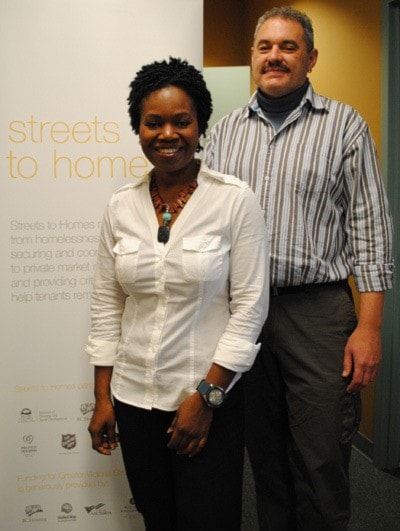Hard-to-house Victorians partake in miracle initiative
Some of Victoria’s hardest-to-house residents are being handed long-term tenancy agreements, thanks to the pilot initiative of a few local partners — and, just in time for the holidays, the results seem to have surprised everyone.
The Streets to Homes pilot program, spearheaded by Greater Victoria Coalition to End Homelessness, has managed to house 84 people so far who were without homes for at least 12 months, and were living with one or more instance of mental health or addictions issues. Of the group, 69 participants were situated in private-market apartments, 10 in supportive housing and five in transitional housing. By the end of the program, which was modelled after a Toronto equivalent, the group hopes to secure housing for a total of 120 participants.
But while the year-and-a-half-long pilot is coming to its completion in January, the participants have proven that “hard-to-house” may be more of a stigmatic myth than many thought — the renters have been largely invisible to neighbours, and most of the group have impressed landlords, too.
“We’ve learned a lot about how we can adapt our program model to fit Victoria … since low vacancy rates and high rents often affect how landlords choose their tenants,” says Debbie Thompson, executive director of the coalition. “The fact that, yes, these people could be living beside you or me is exactly the point — we have no idea what goes on in others’ lives, but we all have these perceptions that certain people cannot be housed. If anything, this is proving how untrue that is.”
In a poll the coalition performed among landlords in the region, surprisingly, paying rent on time was listed as the last of three credentials in finding a prospective tenant. The second was marked as evidence the tenant won’t cause damage, with the first demand being that the tenant will behave in a way that is conducive to the environment.
Fitting, then, that the pilot program provides a rent subsidy, case planning and the assistance of a support worker for each participant, until the tenant becomes self-sufficient. The rent subsidy — which tacks on an extra $300 or so to any pre-existing income assistance — has been secured from the province and BC Housing, while support work and other funding demands came through the works of partners around the region, including Our Place Society, Pacifica Housing, Rental Owners and Managers Society of BC, Salvation Army ARC, United Way of Greater Victoria, Vancouver Island Health Authority, Victoria Cool Aid Society, Victoria Foundation and Victoria Native Friendship Society.
“We want the participants to have as realistic an experience with renting as possible,” says Brad Crewson, Streets to Homes strategic coordinator. “That means we coach them on making a good first impression, we accompany them to the showings to ease some of those nerves or any reservations they may have developed with past landlords, and we look at a few options — so it’s not just this-or-nothing, but finding out what housing situation feels right for them.”
That secured funding will be maintained indefinitely for the participants completing the pilot so far, with more being inducted into the program’s waitlist. But while the coalition has taken the lead on the program’s direction until now, the group hopes to turn it over to Pacifica Housing come January for it to continue into the future. And while some funding has already been secured for 2012, an additional allowance to facilitate the program must come through first in order for it to go ahead for another year.
“Many of these participants haven’t been housed for a very long time, so even things like getting groceries, budgeting your bills, cooking for yourself and cleaning can seem totally overwhelming at first,” says Crewson. “But we have other people who just needed that one leg up, and now they’ve got their independence back. Our goal is to break the cycle.”
Of the participants involved, so far 75 per cent report an ability to access new services now that they’ve found housing, while nearly 40 per cent have been able to find employment, volunteer opportunities, training or access to education.
With rents as low as $600 and as high as $775 in some cases, the group worked to waylay landlord fears, including concerns that select apartments could see an increase in traffic or serve as makeshift hostels for other people living without homes. While Crewson recognizes there is a tremendous pressure on those in the community who find homes and leave their friends, he also adds that the same rules apply as they would to any tenant — respect for the property, and for others.
“One thing I think people would be surprised to hear is that most of the landlords we’ve heard from find our tenants easier to work with than a lot of well-presenting tenants,” says Thompson. “We back the rent and the costs if anything is damaged, and we work with our participants to make sure they have what they need. You or I could look like a great tenant, then bail in the middle of the night — these are people who really want this chance, and who are working to make it happen.”
The pilot has seen two evictions since the beginning of the program, but one participant was successfully re-housed in supportive housing and one is being re-housed in a transitional facility.
“Probably one of the greatest challenges is making sure that the facilities we choose for an individual are the best fit. Then, finding that balance between offering support and respecting independence,” says Crewson. “These are people who are used to being told ‘no.’ We want to change that.” M
To learn more about how you can donate or get involved with the program, visit solvehomelessness.ca.
